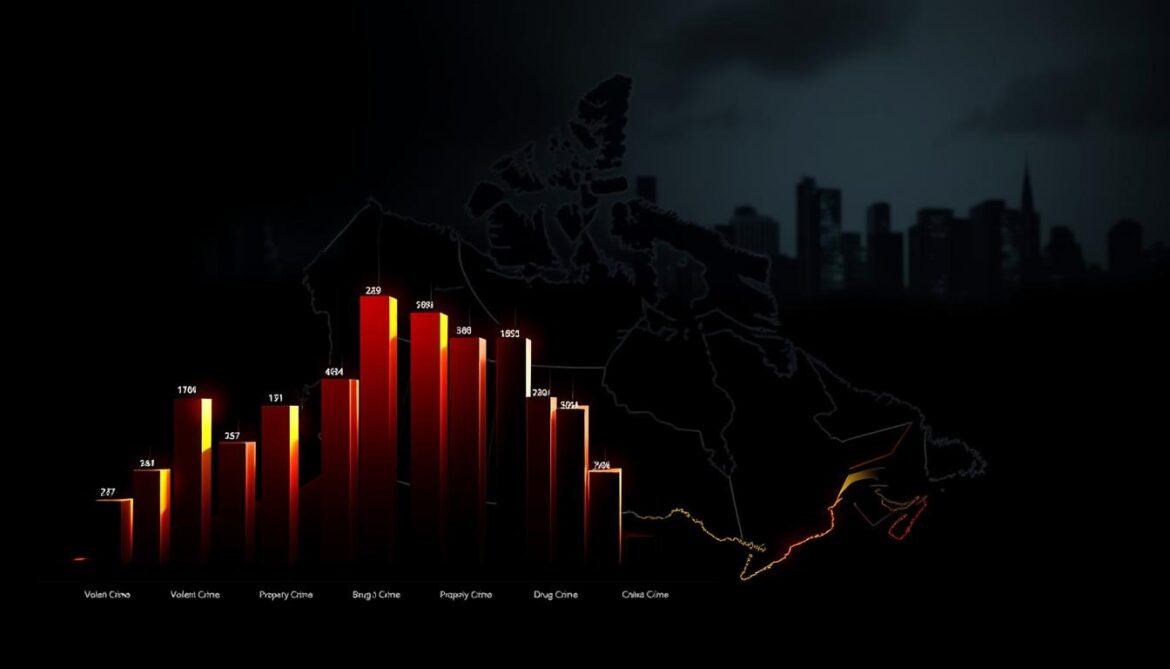Did you know one Canadian city sees a violent incident reported every six minutes? While the country ranks among the world’s safest nations, localized challenges reveal stark contrasts in public safety. At CanadaCrime.ca, we analyze trends to help you navigate this complex landscape.
Crime data from Statistics Canada and police reports shows urban centers face unique risks. Property offenses, assaults, and theft patterns vary widely between provinces. Understanding these nuances helps you stay informed about where and why incidents cluster.
Our analysis covers both violent and non-violent categories. You’ll discover how regional economies, policing strategies, and community programs shape outcomes. We’ve prioritized data from trusted sources like the RCMP to ensure accuracy.
Key Takeaways
- Canada’s safety reputation coexists with elevated incidents in specific cities
- Crime statistics require context about location and crime type
- Non-violent offenses account for 70% of reported cases nationwide
- Winnipeg and Regina consistently rank above national averages
- Seasonal trends impact property-related incidents
Understanding the Canadian Crime Landscape
While often seen as a peaceful nation, public safety dynamics vary dramatically between regions across the country. Urbanization patterns and economic disparities create distinct challenges in different provinces. At Canadacrime.ca, we track how these elements shape security outcomes through verified crime statistics.
Key Crime Drivers
Socioeconomic conditions heavily influence incident patterns. Areas with limited access to education and employment opportunities often show higher violent crime reports. Population density also plays a role – major metros experience 3x more property offenses than rural zones according to Statistics Canada. These drivers contribute significantly to violent crime rates in densely populated areas.

Historical Overview
The Crime Severity Index (CSI) reveals notable shifts since 1998. While total incident rates dropped 25% nationally by 2020, certain Canadian cities like Winnipeg and Halifax saw increases in specific categories. Violent acts here include assaults causing bodily harm and armed robberies under Criminal Code definitions.
Community programs have altered trajectories in hotspots. Vancouver’s Downtown Eastside, for instance, reduced street violence rates by 18% through targeted outreach between 2015-2020. Such data-driven approaches help refine prevention strategies where they matter most.
Breaking Down Crime Statistics by City
How safe is your neighborhood compared to others? At CanadaCrime.ca, we analyze police-reported data to spotlight urban safety variations. Our city-level comparisons reveal patterns hidden in national averages.

Top Cities With Elevated Risk
Recent CSI scores show surprising leaders in urban incidents. Abbotsford, BC, tops the list with a crime index of 126.3 – 34% above the national average. Other notable entries include:
- Red Deer, AB: 119.1 CSI (property crimes dominate)
- Burnaby, BC: 115.7 CSI (non-violent offenses up 12% since 2022)
- Thunder Bay, ON: 113.9 CSI (violent acts per 100k residents: 1,432)
Regional Safety Contrasts
Prairie cities face unique challenges. Saskatoon’s property crime rate (6,210 per 100k) triples Halifax’s figures. Meanwhile, mid-sized Ontario communities like Barrie report 40% fewer violent incidents than western counterparts.
“Metro areas with populations under 500,000 often show sharper seasonal crime fluctuations.” – Statistics Canada analyst
Coastal regions demonstrate different trends. Vancouver’s downtown core reduced non-violent crimes by 18% through surveillance tech adoption. Yet suburban areas saw break-ins rise during commuter hours.
Crime Severity Index Explained
What if a single number could reveal a city’s safety challenges? The Crime Severity Index (CSI) does exactly that. Developed by Statistics Canada, this metric measures both how often crimes occur and how serious they are. Unlike basic crime counts, it gives armed robbery more weight than shoplifting.
How CSI Measures Crime
The severity index uses court sentencing data to assign values. For example:
| Crime Type | Weight | Impact Factor |
|---|---|---|
| First-Degree Murder | 8,200 | 58x national average |
| Assault with Weapon | 700 | 5x average |
| Property Theft | 29 | 0.2x average |
This system means three burglaries (29 x 3 = 87) affect the index less than one armed robbery (700). At CanadaCrime.ca, we use this data to show why Winnipeg’s CSI (123) suggests different safety needs than Ottawa’s (75).
Interpreting CSI Values
A CSI score of 100 matches the national average. Cities above 100 have more severe crime profiles. Consider these 2023 comparisons:
- Regina: 118 CSI (23% above Canada crime index)
- Toronto: 84 CSI (16% below average)
The safety index works inversely—higher numbers mean safer communities. Vancouver’s 92 CSI translates to a 108 safety score, while Prince Albert’s 145 CSI becomes a 55 safety rating. This dual perspective helps you assess risk at the neighborhood level.
Insights into Violent and Non-Violent Crimes
How do violent and property-related incidents shape safety perceptions in your area? At Canadacrime.ca, we break down crime rates to reveal how different offenses impact neighborhoods. Recent patterns show cities face distinct challenges based on offense types and local resources.

Violent Crime Trends
Urban centers saw a 4% rise in violent crimes last year, with Kitchener-Waterloo reporting 23% more assaults than 2022. However, some regions buck this trend:
| City | Violent Incidents (2023) | Change vs 2022 |
|---|---|---|
| Kingston | 1,102 | -8% |
| Sault Ste. Marie | 687 | +14% |
| Burnaby | 892 | +3% |
Sault Ste. Marie’s spike aligns with reduced youth outreach funding, showing how community programs affect outcomes. Weapon-related offenses now account for 38% of violent acts nationally.
Non-Violent Crime Patterns
Property crimes dominate incident reports, making up 71% of cases in 2023. Regina’s auto theft rates tripled since 2020, while Kelowna saw break-ins drop 12% through neighborhood watch initiatives. Key contrasts emerge:
- Non-violent offenses peak during holiday seasons
- Urban centers report 5x more shoplifting than rural areas
- Cybercrime now represents 18% of property-related cases
According to a recent Statistics Canada report, cities with active prevention programs cut non-violent crime levels 22% faster than others. This highlights the importance of tailored strategies for different offense types.
Provincial Crime Comparisons and Trends
Regional safety gaps across Canada’s provinces reveal crucial insights into law enforcement effectiveness and community needs. At Canadacrime.ca, our analysis of Statistics Canada data shows Alberta’s Crime Severity Index (121) leads all provinces, while Nova Scotia sits 24% below the national average.

Urban centers face distinct challenges based on location. Consider these 2023 comparisons:
| Province | CSI Score | Key Challenges |
|---|---|---|
| Alberta | 121 | Property thefts, auto crimes |
| British Columbia | 118 | Organized crime, cyber fraud |
| Ontario | 89 | Retail theft, assaults |
| Quebec | 76 | Financial crimes, burglaries |
Red Deer exemplifies Alberta’s struggles. The city’s property crime rates exceed provincial averages by 37%, though targeted law enforcement patrols reduced thefts 22% last year. British Columbia’s metro areas combat gang activity through youth mentorship programs – Vancouver’s initiative cut youth-related offenses 15% since 2021.
Canada 2025 projections suggest shifting patterns. Alberta could see 8% higher property crimes without expanded community outreach, while British Columbia prepares for cybercrime spikes in coastal cities. These forecasts help local agencies allocate resources where level crime risks peak first.
Urban Safety: Stats from Major Metropolises
Where you live in Canada’s biggest cities could significantly impact your exposure to security risks. At CanadaCrime.ca, we compare urban safety metrics across metropolitan hubs like the Greater Toronto Area (GTA) and Metro Vancouver. These regions exemplify how localized strategies shape community security.

GTA Security Landscape
Toronto’s 2023 safety index of 68 reflects diverse neighborhood experiences. Mississauga reports 23% fewer violent incidents than Brampton, despite similar population sizes. Key patterns emerge:
- Auto thefts increased 34% in Peel Region last year
- Downtown Toronto saw 18% drop in assaults through hotspot policing
- York Region maintains 82 safety score – highest in GTA
Community programs show measurable impact. Scarborough’s youth mentorship initiative reduced break-ins by 41% since 2022. These efforts demonstrate how targeted approaches address specific urban safety challenges.
Metro Vancouver Dynamics
Vancouver’s 74 safety index masks stark contrasts between districts. While property crimes dominate citywide stats, Surrey battles unique challenges:
| City | Violent Incidents/100k | Property Crimes/100k |
|---|---|---|
| Vancouver | 843 | 4,112 |
| Burnaby | 779 | 3,897 |
| Surrey | 901 | 4,563 |
Automated license plate readers in Richmond cut stolen vehicle reports by 29% last quarter. Such tech-driven solutions complement traditional patrols, creating layered defense systems against non-violent crimes.
For residents and visitors, understanding these patterns helps you make informed decisions. Check neighborhood-specific data through local police portals before exploring unfamiliar urban areas.
High Crime Rate in Canada: Data and Analysis
Recent shifts in urban safety metrics reveal crucial patterns that shape community experiences across the country. At Canadacrime.ca, we dissect year-to-year data to show how neighborhoods evolve – and where challenges persist.

Year-over-Year Changes
Kamloops saw its crime index jump 24% last year – from 10,600 to 13,116 incidents per 100k residents. Meanwhile, London, Ontario bucked national trends with a 14% decrease. These contrasts highlight why localized analysis matters:
| City | 2022 CSI | 2023 CSI |
|---|---|---|
| Red Deer | 12,765 | 12,340 |
| Chilliwack | 11,615 | 11,890 |
| Quebec City | 5,200 | 5,410 |
Provincial differences deepen the story. Newfoundland’s index rose 5% while Alberta’s dropped 2%. Such variations influence where cities allocate police resources and prevention budgets.
What the Numbers Mean for You
The national crime index climbed to 80.5 in 2023 – up 2% from 2022. While this suggests broader challenges, specific offense types tell a fuller story:
- Non-violent incidents rose 2% nationwide
- Violent acts remained stable at 99.5 index points
- Cybercrimes now account for 19% of property-related cases
“Three straight years of index increases demand adaptive strategies – what worked yesterday might not suffice tomorrow.”
Looking toward Canada 2025, projections suggest coastal cities could see cybercrime spikes while prairie regions stabilize. Our team at Canadacrime.ca continues monitoring these trends to keep you informed.
Impact of Socioeconomic Factors on Crime
Behind every safety statistic lies a web of unseen forces shaping community experiences. At Canadacrime.ca, we analyze how financial stability and social structures influence security outcomes across neighborhoods.

Economic and Social Influences
Statistics Canada reveals a clear pattern: areas with unemployment above 7% experience 38% more property-related incidents. Regina’s auto theft surge coincided with 2022’s 9.1% jobless rate – triple the national average at the time.
Urban density amplifies these effects. For every 10% increase in population crowding:
- Violent crimes rise 6% in metro areas
- Non-violent offenses jump 12%
- Police response times slow by 4 minutes
| City | Unemployment Rate | Severity Index |
|---|---|---|
| Regina | 8.9% | 118 |
| Saint John | 6.2% | 89 |
“Every 1% drop in median income correlates with 14 more police-reported incidents per 10,000 residents.”
Social programs show measurable impact. Winnipeg’s community centers reduced youth-related crimes 17% through after-school initiatives. These efforts demonstrate how targeted investments disrupt negative cycles.
Understanding these connections helps you interpret local safety data more effectively. Visit Canadacrime.ca for neighborhood-specific insights into how economic health shapes security in your area.
Community Safety Measures and Law Enforcement Efforts
What makes some neighborhoods safer than others? At CanadaCrime.ca, we track how partnerships between residents and law enforcement reshape security outcomes. Recent data shows cities using blended strategies achieve faster reductions in incident rates.
Local Initiatives Making an Impact
Surrey’s Block Watch program reduced break-ins by 31% in 2023 through citizen patrols and real-time alerts. In British Columbia, similar efforts improved weighted clearance rates – a metric valuing serious offense resolutions – by 19% last year.
Tech-Driven Crime Prevention
Vancouver police now use automated license plate readers to track stolen vehicles. This tech helped resolve 42% more property crimes in 2023 compared to 2022. Chief Constable Adam Palmer notes:
“Our weighted clearance rate jumped from 24% to 38% after deploying these tools – that’s 1,200+ cases closed faster.”
Key results from tech adoption:
| City | Tech Implemented | Property Crime Drop |
|---|---|---|
| Calgary | Predictive analytics | 27% (2022-2023) |
| Ottawa | Smart streetlights | 19% fewer thefts |
| Edmonton | Facial recognition | 33% faster suspect ID |
These efforts directly boost safety index scores. Neighborhoods with active programs see 14% higher ratings than areas relying solely on patrols. Check CanadaCrime.ca for local initiatives near you.
Tips for Staying Safe in High-Risk Areas
Your daily routines might expose you to risks you haven’t considered—until now. Cities like Regina and Winnipeg demonstrate how localized safety strategies can reduce vulnerabilities. At CanadaCrime.ca, we translate data into actionable steps to help you navigate urban environments confidently.
Practical Safety Tips
Stay alert in crowded spaces like transit hubs. Thieves often target distracted individuals. Keep valuables concealed and avoid displaying expensive devices openly.
Review neighborhood-specific travel advisories before exploring unfamiliar zones. Many Canadian cities update these weekly based on recent incident patterns.
- Install motion-sensor lights at home entry points – burglaries drop 47% in areas using this method
- Program local police non-emergency numbers into your phone for quick access
- Attend community safety workshops – Surrey residents reduced break-ins 31% through these programs
Track real-time alerts through platforms like Winnipeg’s public notification system. These tools provide crucial updates about released offenders or active threats.
Nighttime navigation requires extra caution. Stick to well-lit routes with steady foot traffic. Cities like Toronto have improved pathway lighting in response to safety audits – follow these upgraded corridors when possible.
Future Outlook: Crime Trends and Predictions for 2025
As 2025 approaches, new patterns in community safety are coming into focus across Canadian cities. At CanadaCrime.ca, we analyze data from Statistics Canada and law enforcement projections to spotlight shifts in the crime severity index. These insights help communities prepare for evolving security challenges.
Emerging Trends
Coastal regions face rising cybercrime threats, with Vancouver projected to see a 27% jump in digital fraud cases by 2025. Meanwhile, prairie cities like Regina may stabilize their index scores through expanded youth outreach programs. Key forecasts include:
| City | 2024 CSI | 2025 Projection |
|---|---|---|
| Toronto | 84 | 79 (-6%) |
| Edmonton | 109 | 105 (-4%) |
| Halifax | 93 | 98 (+5%) |
Non-violent offenses are evolving – Statistics Canada reports 31% of property-related incidents will involve digital elements by 2025. This shift demands updated prevention strategies for both urban and rural areas.
Policy Impact Prediction
New federal funding for mental health services could reduce violent crime rates in high-risk neighborhoods. Proposed legislation targeting auto theft rings may lower related offenses by 19% in Canada 2025. Consider these potential outcomes:
- AI-powered surveillance could cut break-ins by 22% in tech-adopting cities
- Extended social program funding might prevent 4,100+ youth-related incidents annually
- Stricter cyber regulations may reduce online fraud losses by $230 million
“Cities investing in predictive policing tools now could see crime severity index improvements within 18 months.”
Ongoing monitoring at CanadaCrime.ca helps residents and policymakers track how these changes reshape community safety. By understanding emerging trends, you can advocate for measures that address both violent and non-violent crime risks in your area.
Conclusion
What defines safety in a nation known for its peaceful reputation? Our analysis reveals Canada’s security landscape thrives on nuance. Cities like Winnipeg and Vancouver show how localized strategies reshape outcomes, while the Crime Severity Index highlights regional priorities.
Three patterns emerge nationwide. Non-violent incidents dominate reports, yet urban centers battle unique combinations of threats. Community-driven solutions – from Surrey’s Block Watch to predictive policing tech – prove adaptable approaches yield measurable results.
Reliable Canada crime data remains vital for informed decisions. Whether reviewing neighborhood trends or advocating for policy changes, verified statistics empower both residents and law enforcement. Seasonal fluctuations and socioeconomic factors further emphasize the need for dynamic responses.
Stay proactive with CanadaCrime.ca. We continuously update our tools with the latest RCMP reports and urban safety initiatives. Together, awareness and action can transform challenges into opportunities for safer communities.

